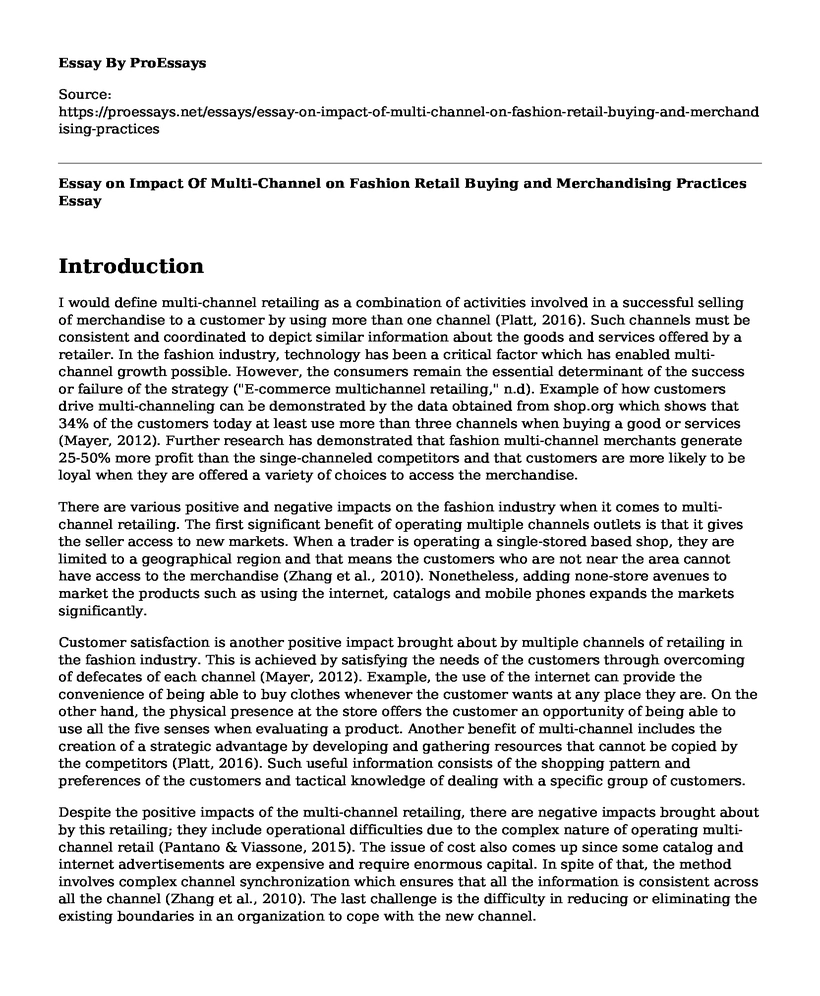Introduction
I would define multi-channel retailing as a combination of activities involved in a successful selling of merchandise to a customer by using more than one channel (Platt, 2016). Such channels must be consistent and coordinated to depict similar information about the goods and services offered by a retailer. In the fashion industry, technology has been a critical factor which has enabled multi-channel growth possible. However, the consumers remain the essential determinant of the success or failure of the strategy ("E-commerce multichannel retailing," n.d). Example of how customers drive multi-channeling can be demonstrated by the data obtained from shop.org which shows that 34% of the customers today at least use more than three channels when buying a good or services (Mayer, 2012). Further research has demonstrated that fashion multi-channel merchants generate 25-50% more profit than the singe-channeled competitors and that customers are more likely to be loyal when they are offered a variety of choices to access the merchandise.
There are various positive and negative impacts on the fashion industry when it comes to multi-channel retailing. The first significant benefit of operating multiple channels outlets is that it gives the seller access to new markets. When a trader is operating a single-stored based shop, they are limited to a geographical region and that means the customers who are not near the area cannot have access to the merchandise (Zhang et al., 2010). Nonetheless, adding none-store avenues to market the products such as using the internet, catalogs and mobile phones expands the markets significantly.
Customer satisfaction is another positive impact brought about by multiple channels of retailing in the fashion industry. This is achieved by satisfying the needs of the customers through overcoming of defecates of each channel (Mayer, 2012). Example, the use of the internet can provide the convenience of being able to buy clothes whenever the customer wants at any place they are. On the other hand, the physical presence at the store offers the customer an opportunity of being able to use all the five senses when evaluating a product. Another benefit of multi-channel includes the creation of a strategic advantage by developing and gathering resources that cannot be copied by the competitors (Platt, 2016). Such useful information consists of the shopping pattern and preferences of the customers and tactical knowledge of dealing with a specific group of customers.
Despite the positive impacts of the multi-channel retailing, there are negative impacts brought about by this retailing; they include operational difficulties due to the complex nature of operating multi-channel retail (Pantano & Viassone, 2015). The issue of cost also comes up since some catalog and internet advertisements are expensive and require enormous capital. In spite of that, the method involves complex channel synchronization which ensures that all the information is consistent across all the channel (Zhang et al., 2010). The last challenge is the difficulty in reducing or eliminating the existing boundaries in an organization to cope with the new channel.
Conclusion
In conclusion, I firmly believe that despite the challenges highlighted, multi-channel retailing poses many advantages in the market. For a successful shift to this retailing, some changes from the traditional business retailing must be instituted mostly in the areas of commercial capacity, technical operations, and organizational processes (Mayer, 2012). Retailers in the fashion industry must focus on the long term goals and benefits instead of the short-term profits. Such visions will entail extensive marketing of their merchandise and embrace multi-channel retailing.
References
E-commerce multichannel retailing. (n.d.). Coordinating Internet Sales with Other Channels, 7-28. doi:10.1007/978-3-8349-9950-4_2
Mayer, F. (2012, June 4). Five Multi-Channel Trends that Impact In-store Merchandising. Retrieved from http://merchandisingmatters.com/2012/06/04/five-multi-channel-trends-that-impact-in-store-merchandising/. Accessed 19 July 2018
Pantano, E., & Viassone, M. (2015). Engaging consumers on new integrated multichannel retail settings: Challenges for retailers. Journal of Retailing and Consumer Services, 25, 106-114. doi:10.1016/j.jretconser.2015.04.003
Platt, R. (2016). Bedeutung der Selbstkongruenz als kaufverhaltensrelevante Grosse im Multichannel-Retailing. Selbstkongruenz im Multichannel-Retailing, 1-19. doi:10.1007/978-3-658-16062-3_1
Zhang, J., Farris, P. W., Irvin, J. W., Kushwaha, T., Steenburgh, T. J., & Weitz, B. A. (2010). Crafting Integrated Multichannel Retailing Strategies. Journal of Interactive Marketing, 24(2), 168-180. doi:10.1016/j.intmar.2010.02.002
Cite this page
Essay on Impact Of Multi-Channel on Fashion Retail Buying and Merchandising Practices. (2022, Jun 30). Retrieved from https://proessays.net/essays/essay-on-impact-of-multi-channel-on-fashion-retail-buying-and-merchandising-practices
If you are the original author of this essay and no longer wish to have it published on the ProEssays website, please click below to request its removal:
- Reflection on Personal and Entrepreneurial Developments Essay
- Retailing and the Change the Business Is Encountering Essay
- Why Do You Do What You Do: Walmart Company Analysis
- Entrepreneurship Annotated Bibliographhy Paper Example
- Essay on the Benefits of International Business: Understanding & Shaping Your Career
- Essay Example on Adhering to Professional Ethics: A Necessity for All
- Essay on Understanding Biasness in Decision-Making: Ethical Considerations







